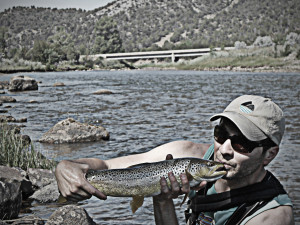“These are strange and breathless days, the dog days, when people are led to do things they are sure to be sorry for after.”
-Natalie Babbitt, Tuck Everlasting
What is it that you could possibly be sorry for after? Well for one, thinking that the dog days of summer, low water, and high nineties heat all add up to one conclusion: the fishing has turned off. While shade and a cold beverage may sound like a good option (and why wouldn’t it?); the fishing is far from ‘off’. However, it may require a little more creativity, innovation, and exploration to get into some fish.
This creativity can be expressed through fishing at off times such as mornings, evenings, and at night. The innovation comes with throwing bugs you never thought you would throw…such as mice, poppers, or jigs…and yes with a fly rod and yes for trout. Last, but the most important factor in finding fish in our hot part of the state: exploration. Our high country is completely open for your hiking boot tread. High mountain secret spots, no name streams, and hidden lakes are all calling for a cast or two. The Weminuche Wilderness out our back door is the home high country cutthroat and has more water than you could fish in a lifetime. Not into hiking? July is high season on the San Juan tailwater with consistent temps making for consistently great fishing.
Although July gets a reputation as the hottest summer month; Southwest Colorado actually gets a reprieve that other parts of the state do not. This reprieve is known as our monsoon season. Yes the monsoon season, the same one written about in countless GI letters back home from Vietnam. Early afternoon thunderstorms roll in each day for a few weeks early July; cooling the weather and watering our parched land. This phenomenon is a blessing in disguise. Although it may take you off the water for a few hours; it makes sure there is water left to fish. Plus it is helping contain our local wildfires.
One word about our local wildfires of which you may have heard a lot about: currently the only local drainage directly affected by this fire season is the Rio Grande. For more information, please visit www.inciweb.org. Please also keep an eye on road closures, especially Highway 160 over Wolf Creek Pass.
Insects and Natural Food Sources
So rather than explain all of the hatches and food for each river for June; we are just going to list the major hatches for each of our major drainages. If you have any questions on any of these, please call the shop for more info. 970-385-4081
San Juan – Hoppers, Midges, annelids, aquatic worms, scuds, eggs, leeches, blue wing olives, caddis, PMDs, large ants, and baitfish in the lower reaches.
Animas – Caddis, PMDs, Tricos, Sculpins, Fingerling Rainbow Trout, Crayfish, Mice, Hoppers.
Rio Grande – Stoneflies, Caddis, PMDs, Green Drakes, Brown Drakes, Mice. (Please by wary of the wildfire situaton)
Piedra River & Williams Creek–Stoneflies; Caddis, PMDs, Tricos, Midges, Craneflies, Drakes, Sculpin and baitfish.
Los Pinos River – (Below Dam) Tricos, Midges, PMDs, Caddis, Baitfish & Leeches.
Dolores River Above Reservoir, Los Pinos Above Reservoir – Ants, beetles, Hoppers, Stoneflies, PMDs, Caddis.
Dolores River (Below Dam) – HOPPERS! PMDs, Caddis, Midges, BWO’s, Rattlesnakes (No seriously lots of rattlesnakes so watch out)
High Country Lakes and Streams – Hoppers, Ants, Beatles, Moths, Mice, bugs…things that look like bugs…but for real High country trout are not too selective. Most high floating attractor patterns will slay. Damsel flies, Chronomids, and Callebaetis in lakes.
Recommended Fly Patterns
Animas, Rio Grande, and SW CO rivers: First off, Parachute Adams of course. For Stones, go for a Chubby Chernobyl, Rogue Foam Stone, Turks Tarantula, or Stimulators size 2-12. Green or black caddis larva and cased caddis nymphs, Hares Ear Nymph, Graphic Caddis, sparkle emerger sz. 12-18. Elk Hair Caddis, Olive X-Caddis, Parachute Caddis, Peacock Caddis, Foam Caddis all size 12-18. PMDs: pheasant tail, WD-40, Barrs Emerger, Foam wing RS2, Parachute Adams, PMD Sparkle Dun in sizes 14-18. Hoppers in size 8-12 such as Chubby Chernobyl, Grillo’s Pool Toy, Turk’s Tarantula, Morrish Hopper. If you are packing some streamers you may want to keep them a little smaller this time of year; Olive Krystal Buggers, Near Nuff Crayfish, Near Nuff Sculpin, Josh’s Ziwi in sizes 6-12. On the Rio Grande, you should pack a few Green and Grey drake patterns such as the Film Critic and Parachute green drake in your box.
San Juan River: Olive and tan scuds sizes 14-18. BWO’s Sz.18-22; Two Bit Hooker, Juju baetis, WD-40s, Pheasant Tail, RS-2s, CDC Comparaduns. Midges Sz.18-26; Scissorbill Special, Red Brassie, Big Mac, Griffith Gnats, and Zebra Midges. Brown, Olive, and White bunny leaches or buggers of the same color. Tan chamois Leeches size 16. Red annelids Sz. 20-22. San Juan Worms, Sz. 16-20 in tan, pink, or orange. Egg patterns, Sz. 16 in orange, pink, and cherise. Hoppers in size 8-14 such as Chubby Chernobyl, Black Stimulator, Turk’s Tarantula, and Morrish Hopper.
For the high country streams; most, if not all attractor patterns will work. Have some Humpies, Royal Wulffs, Stimulators, Elk Hair Caddis, Turks Tarantula, or Parachute Adams on hand in sizes 8-16. If you must go under, a size 10 olive bugger, Copper Johns, and Pheasant Tails always seem to work. These fish are not too selective and now is the time to discover your new secret spot.









